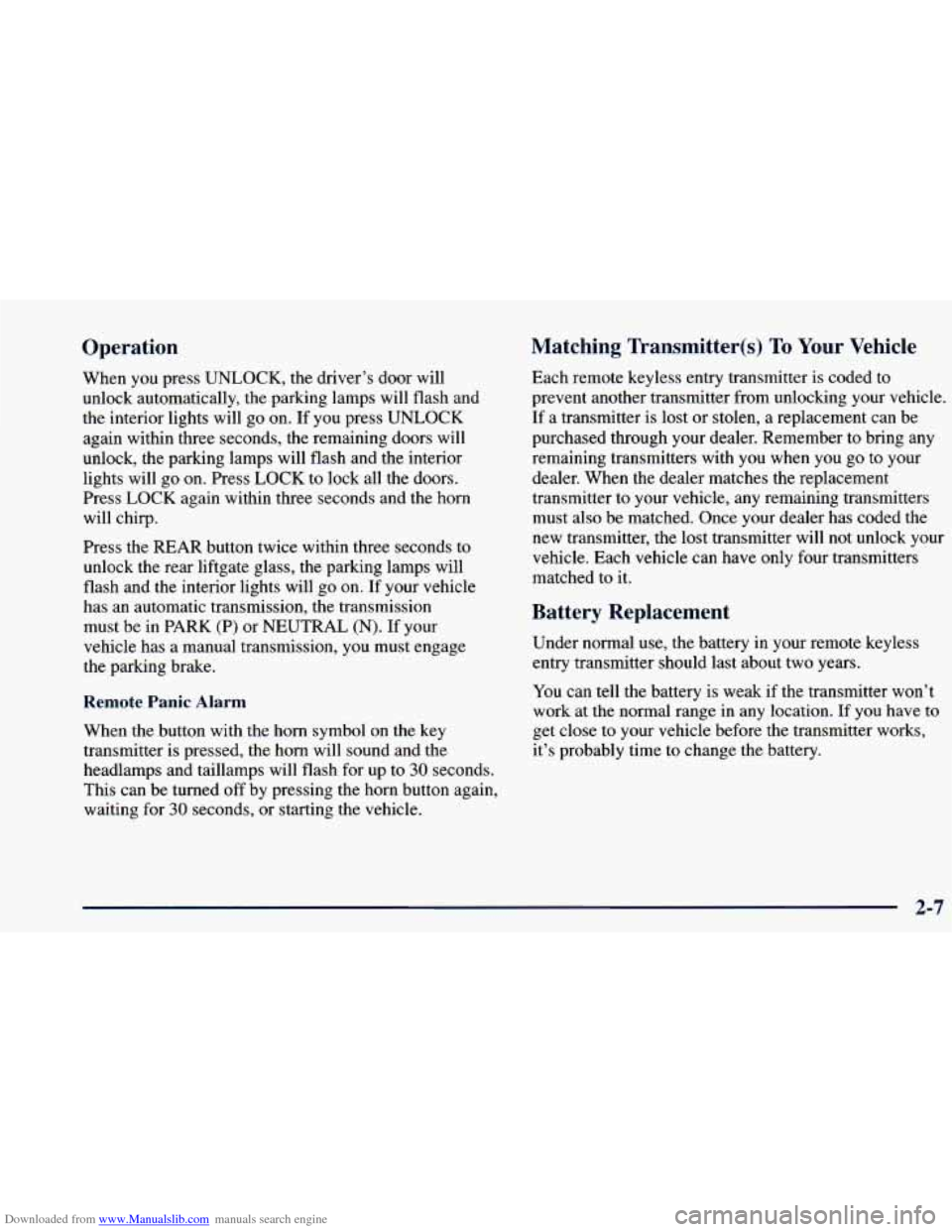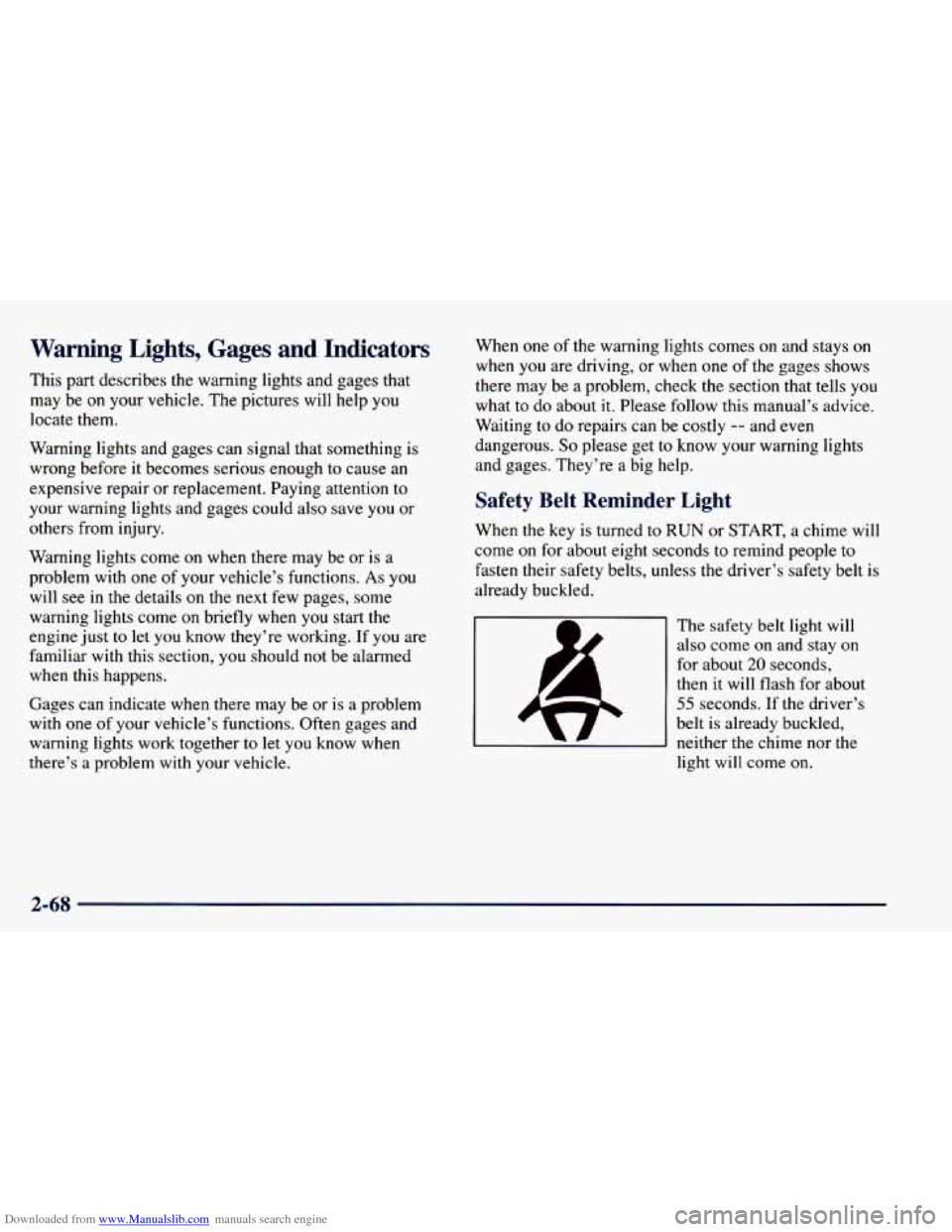alarm CHEVROLET BLAZER 1998 2.G Owners Manual
[x] Cancel search | Manufacturer: CHEVROLET, Model Year: 1998, Model line: BLAZER, Model: CHEVROLET BLAZER 1998 2.GPages: 416, PDF Size: 22.4 MB
Page 81 of 416

Downloaded from www.Manualslib.com manuals search engine Operation Matching Transmitter(s) To Your Vehicle
When you
press UNLOCK, the driver’s door will
unlock automatically, the parking lamps will flash and
the interior lights will go on. If you press UNLOCK
again within three seconds, the remaining doors will
unlock, the parking lamps will flash and the interior
lights will go on. Press LOCK to
lock all the doors.
Press LOCK again within three seconds and the horn
will chirp.
Press the REAR button twice within three seconds to
unlock the rear liftgate glass, the parking lamps will
flash and the interior lights will go on. If your vehicle
has an automatic transmission, the transmission
must be in PARK
(P) or NEUTRAL (N). If your
vehicle has a manual transmission, you must engage
the parking brake.
Remote Panic Alarm
When the button with the horn symbol on the key
transmitter is pressed, the horn will sound and the
headlamps and taillamps will flash for up to
30 seconds.
This can be turned off by pressing the horn button again,
waiting for
30 seconds, or starting the vehicle. Each
remote keyless entry transmitter is coded to
prevent another transmitter from unlocking your vehicle.
If a transmitter is lost or stolen, a replacement can be
purchased through your dealer. Remember to bring
any
remaining transmitters with you when you go to your
dealer. When the dealer matches the replacement
transmitter to your vehicle, any remaining transmitters
must also be matched. Once your dealer has coded the
new transmitter, the lost transmitter will not unlock your
vehicle. Each vehicle can have only four transmitters
matched
to it.
Battery Replacement
Under normal use, the battery in your remote keyless
entry transmitter should last about two years.
You
can tell the battery is weak if the transmitter won’t
work at
the normal range in any location. If you have to
get close to your vehicle before the transmitter works,
it’s probably time to change the battery.
2-7
Page 142 of 416

Downloaded from www.Manualslib.com manuals search engine Warning Lights, Gages and Indicators
This part describes the warning lights and gages that
may be
on your vehicle. The pictures will help you
locate them.
Warning lights and gages can signal that something is
wrong before it becomes serious enough to cause an
expensive repair or replacement. Paying attention to
your warning lights and gages
could also save you or
others from injury.
Warning lights come on when there may be or is a
problem with one
of your vehicle’s functions. As you
will see in the details on the next few pages, some
warning lights come on briefly when
you start the
engine just to let
you know they’re working. If you are
familiar with this section, you should not be alarmed
when this happens.
Gages can indicate when there may be or is a problem
with one of
your vehicle’s functions. Often gages and
warning lights work together to let
you know when
there’s a problem with your vehicle. When
one of the warning lights comes on and stays on
when you
are driving, or when one of the gages shows
there may be a problem, check the section that tells you
what to do about it. Please follow this manual’s advice.
Waiting
to do repairs can be costly -- and even
dangerous.
So please get to know your warning lights
and gages. They’re a big help.
Safety Belt Reminder Light
When the key is turned to RUN or START, a chime will
come
on for about eight seconds to remind people to
fasten their safety belts, unless the driver’s safety belt is
already buckled.
The safety belt light will
also come
on and stay on
for about
20 seconds,
then it will flash for about
55 seconds. If the driver’s
belt
is already buckled,
neither the chime nor the
light will come
on.
2-68